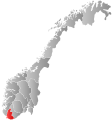Finsland (municipality)
Finsland herred | |
|---|---|
 | |
 Vest-Agder within Norway | |
 Finsland within Vest-Agder | |
| Coordinates: 58°17′23″N 07°36′51″E / 58.28972°N 7.61417°ECoordinates: 58°17′23″N 07°36′51″E / 58.28972°N 7.61417°E | |
| Country | Norway |
| County | Vest-Agder |
| District | Sørlandet |
| Established | 1 Jan 1838 |
| Disestablished | 1 Jan 1964 |
| Administrative centre | Finsland |
| Area | |
| • Total | 118 km2 (46 sq mi) |
| *Area at municipal dissolution. | |
| Population (1964) | |
| • Total | 831 |
| • Density | 7.0/km2 (18/sq mi) |
| Time zone | UTC+01:00 (CET) |
| • Summer (DST) | UTC+02:00 (CEST) |
| ISO 3166 code | NO-1023 |
| Created as | Formannskapsdistrikt in 1838 |
| Succeeded by | Songdalen in 1964 |
Finsland is a former municipality in the old Vest-Agder county, Norway. The 118-square-kilometre (46 sq mi) municipality existed from 1838 until its dissolution in 1964. The administrative centre was the village of Finsland where Finsland Church is located. The municipality generally encompassed the northern part of the present-day municipality of Kristiansand in what is now Agder county.
History[]
The parish of Finsland was established as a municipality on 1 January 1838 (see formannskapsdistrikt law). During the 1960s, there were many municipal mergers across Norway due to the work of the Schei Committee. On 1 January 1964, Finsland municipality was dissolved and its lands split between two municipalities. The small area of Finsland near Kleveland bru (population: 34) was transferred to the neighboring Marnardal municipality and the rest of Finsland (population: 797) was merged with the municipality of Greipstad (population: 2,061) and the Eikeland area of Øvrebø (population: 39) to form the new municipality of Songdalen. Prior to the merger, the population of Finsland was 831.[1]
Name[]
The municipality (originally the parish) was named Finsland, after the old "Finsland" farm which is where the Finsland Church is located. The farm is situated by the river Finnsåna, which flows into the river Mandalselva. There are also farms nearby called Finsdal and Finsådal. The first element is the word finne means "wilderness" or "remote". The second element land is the same as the word for "land".[2]
Government[]
All municipalities in Norway, including Finsland, are responsible for primary education (through 10th grade), outpatient health services, senior citizen services, unemployment and other social services, zoning, economic development, and municipal roads. The municipality was governed by a municipal council of elected representatives, which in turn elected a mayor.[3]
Municipal council[]
The municipal council (Herredsstyre) of Finsland was made up of representatives that were elected to four year terms. The party breakdown of the final municipal council was as follows:
| Party Name (in Norwegian) | Number of representatives | |
|---|---|---|
| Labour Party (Arbeiderpartiet) | 1 | |
| Christian Democratic Party (Kristelig Folkeparti) | 2 | |
| Centre Party (Senterpartiet) | 9 | |
| Liberal Party (Venstre) | 1 | |
| Total number of members: | 13 | |
| Party Name (in Norwegian) | Number of representatives | |
|---|---|---|
| Christian Democratic Party (Kristelig Folkeparti) | 2 | |
| Farmers' Party (Bondepartiet) | 10 | |
| Liberal Party (Venstre) | 1 | |
| Total number of members: | 13 | |
| Party Name (in Norwegian) | Number of representatives | |
|---|---|---|
| Labour Party (Arbeiderpartiet) | 1 | |
| Christian Democratic Party (Kristelig Folkeparti) | 2 | |
| Joint List(s) of Non-Socialist Parties (Borgerlige Felleslister) | 8 | |
| Local List(s) (Lokale lister) | 1 | |
| Total number of members: | 12 | |
| Party Name (in Norwegian) | Number of representatives | |
|---|---|---|
| Labour Party (Arbeiderpartiet) | 1 | |
| Joint List(s) of Non-Socialist Parties (Borgerlige Felleslister) | 11 | |
| Total number of members: | 12 | |
| Party Name (in Norwegian) | Number of representatives | |
|---|---|---|
| Labour Party (Arbeiderpartiet) | 1 | |
| Joint List(s) of Non-Socialist Parties (Borgerlige Felleslister) | 11 | |
| Total number of members: | 12 | |
| Party Name (in Norwegian) | Number of representatives | |
|---|---|---|
| Labour Party (Arbeiderpartiet) | 1 | |
| Farmers' Party (Bondepartiet) | 9 | |
| Joint List(s) of Non-Socialist Parties (Borgerlige Felleslister) | 2 | |
| Total number of members: | 12 | |
See also[]
References[]
- ^ Jukvam, Dag (1999). "Historisk oversikt over endringer i kommune- og fylkesinndelingen" (PDF) (in Norwegian). Statistisk sentralbyrå.
- ^ Rygh, Oluf (1912). Norske gaardnavne: Lister og Mandals amt (in Norwegian) (9 ed.). Kristiania, Norge: W. C. Fabritius & sønners bogtrikkeri. p. 118.
- ^ Hansen, Tore, ed. (12 May 2016). "kommunestyre". Store norske leksikon (in Norwegian). Kunnskapsforlaget. Retrieved 21 November 2020.
- ^ "Kommunevalgene og Ordførervalgene 1959" (PDF) (in Norwegian). Oslo: Statistisk sentralbyrå. 1960. Retrieved 21 November 2020.
- ^ "Kommunevalgene og Ordførervalgene 1955" (PDF) (in Norwegian). Oslo: Statistisk sentralbyrå. 1957. Retrieved 21 November 2020.
- ^ "Kommunevalgene og Ordførervalgene 1951" (PDF) (in Norwegian). Oslo: Statistisk sentralbyrå. 1952. Retrieved 21 November 2020.
- ^ "Kommunevalgene og Ordførervalgene 1947" (PDF) (in Norwegian). Oslo: Statistisk sentralbyrå. 1948. Retrieved 21 November 2020.
- ^ "Kommunevalgene og Ordførervalgene 1945" (PDF) (in Norwegian). Oslo: Statistisk sentralbyrå. 1947. Retrieved 21 November 2020.
- ^ "Kommunevalgene og Ordførervalgene 1937" (PDF) (in Norwegian). Oslo: Statistisk sentralbyrå. 1938. Retrieved 21 November 2020.
External links[]
- 1960 census and map of Finsland (in Norwegian)
- Songdalen
- Former municipalities of Norway
- 1838 establishments in Norway
- 1964 disestablishments in Norway


